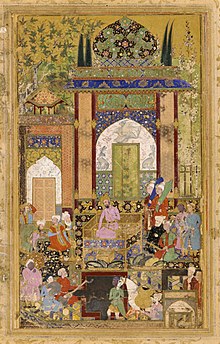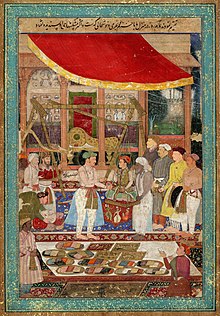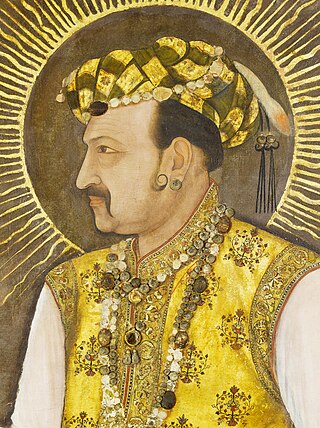
Nur-ud-Din Muhammad Salim, known by his imperial name Jahangir, was the fourth Mughal Emperor, who ruled from 1605 until his death in 1627. He was the third and only surviving son of Emperor Akbar and his chief empress, Mariam-uz-Zamani, born to them in the year 1569. Nuruddin Muhammad Salim was named after the revered Indian Sufi saint Salim Chishti.

Ustad Mansur was a seventeenth-century Indian painter and naturalist who served as a Mughal court artist. During which period he excelled at depicting plants and animals. He was the earliest artist to depict the dodo in colour, apart from being the first to illustrate the Siberian crane. Towards the end of Akbar's reign, he gained the title of ustad (master) and during the reign of Mughal Emperor Jahangir his masterpieces earned him the title of Nãdir-al-’Asr. Although he was largely known for his natural history illustrations, he also portrayed people in various manuscript illustrations.

Rajput painting, painting of the regional Hindu courts during the Mughal era, roughly from the end of the 16th century to the middle of the 19th century. Traditionally, Rajput painting is further divided into Rajasthan and Pahari painting which flourished in two different areas "far apart from each other in terms of distance but all under the rule of Rajput chiefs, and bound together by a common culture".

The Bāburnāma is the memoirs of Ẓahīr-ud-Dīn Muhammad Bābur (1483–1530), founder of the Mughal Empire and a great-great-great-grandson of Timur. It is written in the Chagatai language, known to Babur as Türki "Turkic", the spoken language of the Timurids.

The Akbarnama, is the official chronicle of the reign of Akbar, the third Mughal Emperor, commissioned by Akbar himself and written by his court historian and biographer, Abu'l-Fazl ibn Mubarak. It was written in Persian, which was the literary language of the Mughals, and includes vivid and detailed descriptions of his life and times. It followed the Baburnama, the more personal memoir by his grandfather, Babur, founder of the dynasty. It was produced in the form of lavishly illustrated manuscripts.

Bishandas was a 17th-century Mughal painter at the court of the Mughal emperor Jahangir (1569–1627), specializing in portraits. Jahangir praised him as "unrivalled in the art of portraiture". Though little is known of Bishandas’ life, his name suggests he was a Hindu, like several others in the imperial workshop. In 1613 he was sent on a diplomatic mission to Persia, to paint the portraits of Shah Abbas I of Persia (1571–1629) and other leading Persian figures. Here he was so successful that he remained until 1620, and on his return Jahangir gave him an elephant.

Padshahnama or Badshah Nama is a group of works written as the official history of the reign of the Mughal Emperor Shah Jahan I. Unillustrated texts are known as Shahjahannama, with Padshahnama used for the illustrated manuscript versions. These works are among the major sources of information about Shah Jahan's reign. Lavishly illustrated copies were produced in the imperial workshops, with many Mughal miniatures. Although military campaigns are given the most prominence, the illustrations and paintings in the manuscripts of these works illuminate life in the imperial court, depicting weddings and other activities.

Tuzuk-e-Jahangiri or Tuzuk-i-Jahangiri or Jahangir-nama is the autobiography of Mughal Emperor Jahangir (1569–1627). Also referred to as Jahangirnama, the Tuzk-e-Jahangiri is written in Persian, and follows the tradition of his great-grandfather, Babur (1487–1530), who had written the Baburnama; though Jahangir went a step further and besides writing on the history of his reign, he included details such as his reflections on art, politics, and information about his family.

Govardhan was a Mughal era Indian painter of the Mughal school of painting. His father Bhavani Das, had been a minor painter in the imperial workshop. Like many other Mughal painters, they were Hindus. He joined the imperial service during the reign of Akbar and he continued his work till the reign of Shah Jahan. The examples of his work survived till date show that he was fond of rich, sensuous colour and softly modeled forms.

Tutinama, literal meaning "Tales of a Parrot", is a 14th-century series of 52 stories in Persian. The work remains well-known largely because of a number of lavishly illustrated manuscripts, especially a version containing 250 miniature paintings commissioned by the Mughal Emperor Akbar in the 1550s. The Persian text used was edited in the 14th century from an earlier anthology ‘Seventy Tales of the Parrot’ in Sanskrit compiled under the title Śukasaptati dated to the 12th century. In India, parrots are popular as storytellers in works of fiction.

Farrukh Beg, also known as Farrukh Husayn, was a Persian miniature painter, who spent a bulk of his career in Safavid Iran and Mughal India, praised by Mughal Emperor Jahangir as "unrivaled in the age."

'Abd al-Ṣamad or Khwaja 'Abd-us-Ṣamad was a 16th century painter of Persian miniatures who moved to India and became one of the founding masters of the Mughal miniature tradition, and later the holder of a number of senior administrative roles. 'Abd's career under the Mughals, from about 1550 to 1595, is relatively well documented, and a number of paintings are authorised to him from this period. From about 1572 he headed the imperial workshop of the Emperor Akbar and "it was under his guidance that Mughal style came to maturity". It has recently been contended by a leading specialist, Barbara Brend, that Samad is the same person as Mirza Ali, a Persian artist whose documented career seems to end at the same time as Abd al-Samad appears working for the Mughals.
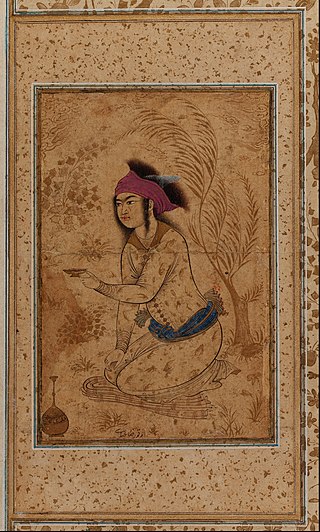
A Muraqqa is an album in book form containing Islamic miniature paintings and specimens of Islamic calligraphy, normally from several different sources, and perhaps other matter. The album was popular among collectors in the Islamic world, and by the later 16th century became the predominant format for miniature painting in the Persian Safavid, Mughal and Ottoman empires, greatly affecting the direction taken by the painting traditions of the Persian miniature, Ottoman miniature and Mughal miniature. The album largely replaced the full-scale illustrated manuscript of classics of Persian poetry, which had been the typical vehicle for the finest miniature painters up to that time. The great cost and delay of commissioning a top-quality example of such a work essentially restricted them to the ruler and a handful of other great figures, who usually had to maintain a whole workshop of calligraphers, artists and other craftsmen, with a librarian to manage the whole process.
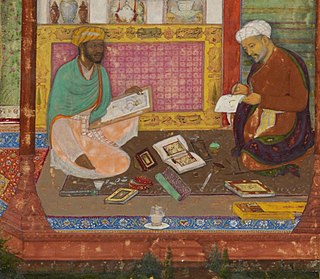
The illuminated manuscript Khamsa of Nizami British Library, Or. 12208 is a lavishly illustrated manuscript of the Khamsa or "five poems" of Nizami Ganjavi, a 12th-century Persian poet, which was created for the Mughal Emperor Akbar in the early 1590s by a number of artists and a single scribe working at the Mughal court, very probably in Akbar's new capital of Lahore in North India, now in Pakistan. Apart from the fine calligraphy of the Persian text, the manuscript is celebrated for over forty Mughal miniatures of the highest quality throughout the text; five of these are detached from the main manuscript and are in the Walters Art Museum, Baltimore as Walters Art Museum MS W.613. The manuscript has been described as "one of the finest examples of the Indo-Muslim arts of the book", and "one of the most perfect of the de luxe type of manuscripts made for Akbar".

Mir Sayyid Ali was a Persian miniature painter who was a leading artist of Persian miniatures before working under the Mughal dynasty in India, where he became one of the artists responsible for developing the style of Mughal painting, under Emperor Akbar.
Ghulam Ali Khan was a nineteenth century Indian painter in Delhi. His painting career took place over the course of more than four decades, from 1817 to 1852. He was the last royal Mughal painter, and also painted in the Company style for British patrons.

Deccan painting or Deccani painting is the form of Indian miniature painting produced in the Deccan region of Central India, in the various Muslim capitals of the Deccan sultanates that emerged from the break-up of the Bahmani Sultanate by 1520. These were Bijapur, Golkonda, Ahmadnagar, Bidar, and Berar. The main period was between the late 16th century and the mid-17th, with something of a revival in the mid-18th century, by then centred on Hyderabad.

Muhammad Daulat was a leading artist in Mughal painting, active on imperial commissions between about 1595 and 1635–1640, during the reigns of Akbar, Jahangir, and Shah Jahan. He began his career painting large narrative scenes, then specialized in portraits, but later in his career seems to have specialized in highly ornate borders to miniatures.
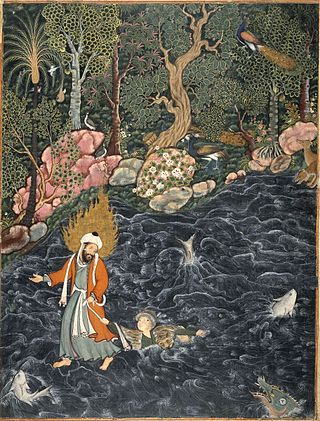
The Akbar Hamzanama is an enormous illustrated manuscript, now fragmentary, of the Persian epic Hamzanama commissioned by the Mughal emperor Akbar around 1562.

Nadiri was a type of a overcoat that was specifically reserved for the Mughal emperor Jahangir and his esteemed courtiers. The vest was an invention of his own, which he had named 'Nadiri'. Nadiri was known as kurdi among the people in Persia. The term 'nadiri' was meant to refer to rarity.




